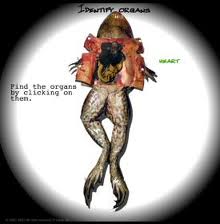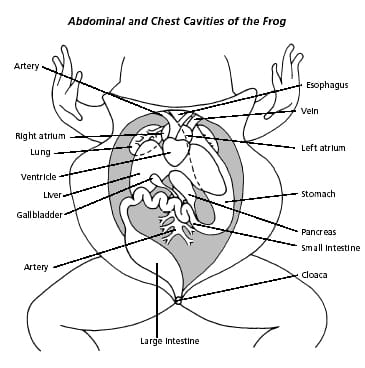Background:
As members of the class Amphibia, frogs may live some of their adult lives on land, but they must return to water to reproduce. Eggs are laid and fertilized in the water. On the outside of the frog’s head are two external nares, or nostrils; two tympani (tympanic membranes), or eardrums; and two eyes, each of which has three lids.
The third lid, called the nictitating membrane, is transparent. Inside the mouth are two internal nares, or openings into the nostrils; two vomerine teeth in the middle of the roof of the mouth; and two maxillary teeth at the sides of the mouth. Also inside the mouth behind the tongue is the pharynx, or throat.
In the pharynx, there are several openings: one into the esophagus, the tube into which food is swallowed; one into the glottis, through which air enters the larynx, or voice box; and two into the Eustachian tubes, which connect the pharynx to the ear. The digestive system consists of the organs of the digestive tract, or food tube, and the digestive glands.
From the esophagus, swallowed food moves into the stomach and then into the small intestine. Bile is a digestive juice made by the liver and stored in the gallbladder. Bile flows into a tube called the common bile duct, into which pancreatic juice, a digestive juice from the pancreas, also flows. The contents of the common bile duct flow into the small intestine, where most of the digestion and absorption of food into the bloodstream takes place.
Indigestible materials pass through the large intestine and then into the cloaca, the common exit chamber of the digestive, excretory, and reproductive systems. The respiratory system consists of the nostrils and the larynx, which opens into two lungs, hollow sacs with thin walls. The walls of the lungs are filled with capillaries, which are microscopic blood vessels through which materials pass into and out of the blood.
The circulatory system consists of the heart, blood vessels, and blood. The heart has two receiving chambers, or atria, and one sending chamber, or ventricle. Blood is carried to the heart in vessels called veins. Veins from different parts of the body enter the right and left atria. Blood from both atria goes into the ventricle and then is pumped into the arteries, which are blood vessels that carry blood away from the heart.
The urinary system consists of the frog’s kidneys, ureters, bladder, and cloaca. The kidneys are organs that excrete urine. Connected to each kidney is a ureter, a tube through which urine passes into the urinary bladder, a sac that stores urine until it passes out of the body through the cloaca. The organs of the male reproductive system are the testes, sperm ducts, and cloaca.
Those of the female system are the ovaries, oviducts, uteri, and cloaca. The testes produce sperm, or male sex cells, which move through sperm ducts, tubes that carry sperm into the cloaca, from which the sperm move outside the body. The ovaries produce eggs, or female sex cells, which move through oviducts into the uteri, then through the cloaca outside the body.
The central nervous system of the frog consists of the brain, which is enclosed in the skull, and the spinal cord, which is enclosed in the backbone. Nerves branch out from the spinal cord. The frog’s skeletal and muscular systems consist of its framework of bones and joints, to which nearly all the voluntary muscles of the body are attached.
Voluntary muscles, which are those over which the frog has control, occur in pairs of flexors and extensors. When a flexor of a leg or other body part contracts, that part is bent. When the extensor of that body part contracts, the part straightens.
The Frog Organs
| Fat Bodies –Spaghetti-shaped structures that have a bright orange or yellow color, if you have a particularly fat frog, these fat bodies may need to be removed to see the other structures. Usually, they are located just on the inside of the abdominal wall. | |
| Peritoneum A spider web like membrane that covers many of the organs, you may have to carefully pick it off to get a clear view | |
| Liver–The largest structure of the body cavity. This brown colored organ is composed of three parts, or lobes. The right lobe, the left anterior lobe, and the left posterior lobe. The liver is not primarily an organ of digestion, it does secrete a digestive juice called bile. Bile is needed for the proper digestion of fats. | |
| Heart – at the top of the liver, the heart is a triangular structure. The left and right atrium can be found at the top of the heart. A single ventricle located at the bottom of the heart. The large vessel extending out from the heart is the conus arteriosis. You will be removing the heart later for further study. | |
| Lungs – Locate the lungs by looking underneath and behind the heart and liver. They are two spongy organs. Insert a dropper into the glottis of the frog. Pump air into the lungs and observe what happens. | |
| Gall bladder–Lift the lobes of the liver, there will be a small green sac under the liver. This is the gall bladder, which stores bile. (hint: it kind of looks like a booger) | |
| Stomach–Curving from underneath the liver is the stomach. The stomach is the first major site of chemical digestion. Frogs swallow their meals whole. Follow the stomach to where it turns into the small intestine. The pyloric sphincter valve regulates the exit of digested food from the stomach to the small intestine. | |
| Small Intestine–Leading from the stomach. The first straight portion of the small intestine is called the duodenum, the curled portion is the ileum. The ileum is held together by a membrane called the mesentery. Note the blood vessels running through the mesentery, they will carry absorbed nutrients away from the intestine. The absorption of digested nutrients occurs in the small intestine. | |
| Large Intestine–As you follow the small intestine down, it will widen into the large intestine. The large intestine is also known as the cloaca in the frog. The cloaca is the last stop before wastes, sperm, or urine exit the frog’s body. (The word “cloaca” means sewer) | |
| Spleen–Return to the folds of the mesentery, this dark red spherical object serves as a holding area for blood and removes old blood cells from circulation. | |
| Esophagus–Return to the stomach and follow it upward, where it gets smaller is the beginning of the esophagus. The esophagus is the tube that leads from the frog’s mouth to the stomach. Open the frog’s mouth and find the esophagus, poke your probe into it and see where it leads. |
The Urogenital System
The urogenital system of the frog consists of organs that function in reproduction and excretion. You will need to locate all of the structures regardless of whether your frog is a male or a female. You will need to look at other groups’ frogs in order to complete the dissection. Check the box when you have located the structure. The descriptions of their locations and appearance will help you label the diagrams.
Study and Removal of the Frog’s Brain
Turn the frog dorsal side up. Cut away the skin and flesh on the head from the nose to the base of the skull. With a scalpel, scrape the top of the skull until the bone is thin and flexible. Be sure to scrape AWAY from you. With your scalpel held almost horizontally, carefully chip away the roof of the skull to expose the brain. Use scissors to cut away the heavier bone along the sides of the brain.
Carefully remove the thin, gray membrane covering the brain. Find the nasal pits at the anterior end of the brain. The olfactory nerves leave these structures and connect to the most anterior lobes of the brain, the olfactory lobes
Just posterior to the olfactory lobes are two elongate bodies with rounded bases, this is the cerebrum, and it is the frog’s thinking center. The cerebrum is the part of the brain that helps the frog respond to its environment. Posterior to the cerebrum are the optic lobes, which function in vision. The ridge just behind the optic lobes is the cerebellum, it is used to coordinate the frog’s muscles and maintain balance. Posterior to the cerebellum is the medulla oblongata, which connects the brain to the spinal cord.


